West Gate Bridge Collapse: A Case Study in Structural Engineering
VerifiedAdded on 2023/06/03
|11
|3134
|202
Case Study
AI Summary
This case study meticulously examines the West Gate Bridge collapse, a catastrophic event resulting from a combination of structural design flaws and construction errors. The report details the initial decision to use concrete ballast to correct a camber difference in the bridge's girders, which led to buckling and subsequent attempts to rectify the issue. The failed repair efforts culminated in the collapse of a 112-meter span, causing significant loss of life and property damage. The study reviews the investigations conducted by the coroner and the royal commission, highlighting critical failures in communication, miscalculations, and overall inefficiency among the project's key participants. The report concludes by outlining how better communication, rigorous stress checks, and adherence to established engineering practices could have prevented the tragedy, emphasizing the importance of professional responsibility and thoroughness in civil engineering projects. Desklib provides students access to this case study along with similar solved assignments and past papers.

Society, Sustainability and Engineering 1
SOCIETY, SUSTAINABILITY AND ENGINEERING
By Name
Course
Instructor
Institution
Location
Date
SOCIETY, SUSTAINABILITY AND ENGINEERING
By Name
Course
Instructor
Institution
Location
Date
Paraphrase This Document
Need a fresh take? Get an instant paraphrase of this document with our AI Paraphraser
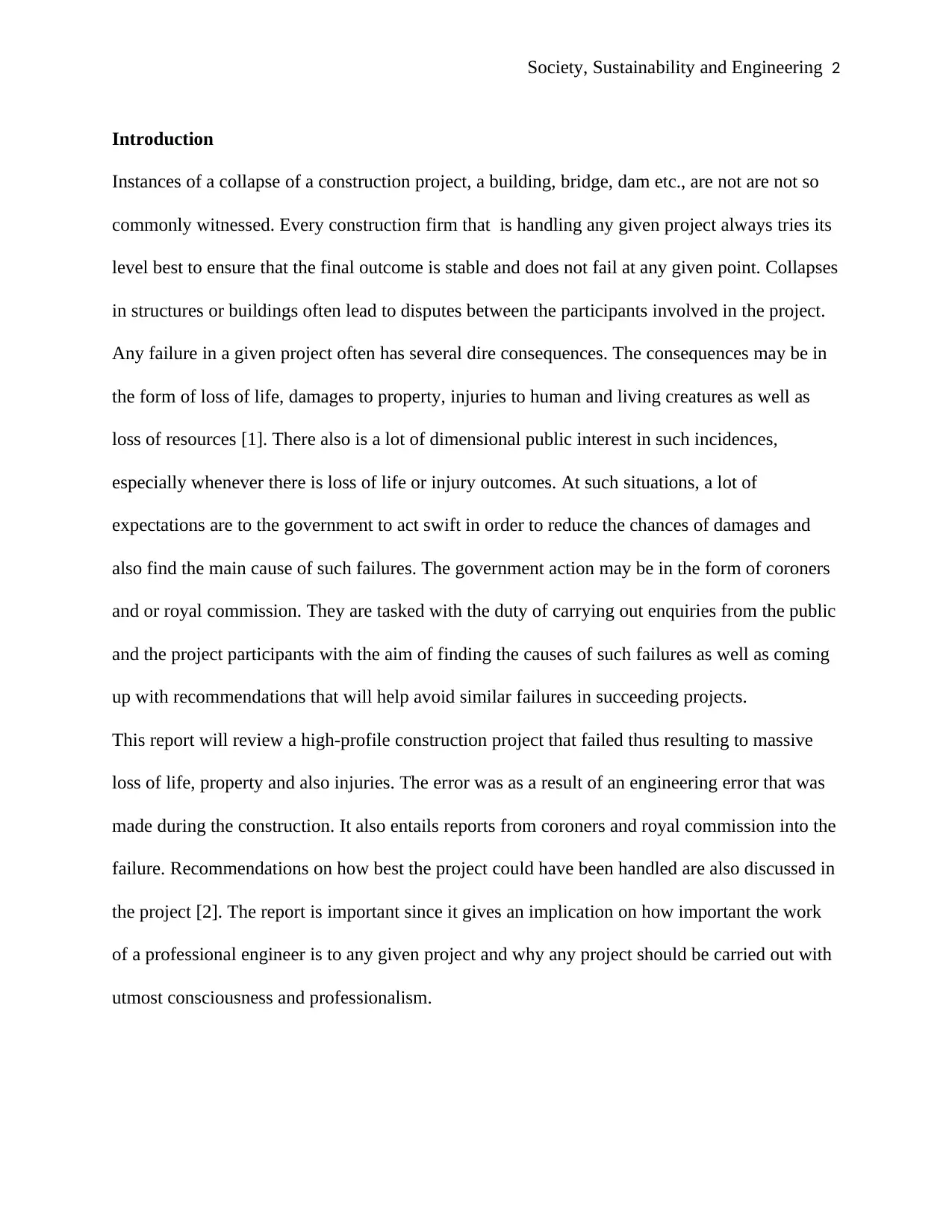
Society, Sustainability and Engineering 2
Introduction
Instances of a collapse of a construction project, a building, bridge, dam etc., are not are not so
commonly witnessed. Every construction firm that is handling any given project always tries its
level best to ensure that the final outcome is stable and does not fail at any given point. Collapses
in structures or buildings often lead to disputes between the participants involved in the project.
Any failure in a given project often has several dire consequences. The consequences may be in
the form of loss of life, damages to property, injuries to human and living creatures as well as
loss of resources [1]. There also is a lot of dimensional public interest in such incidences,
especially whenever there is loss of life or injury outcomes. At such situations, a lot of
expectations are to the government to act swift in order to reduce the chances of damages and
also find the main cause of such failures. The government action may be in the form of coroners
and or royal commission. They are tasked with the duty of carrying out enquiries from the public
and the project participants with the aim of finding the causes of such failures as well as coming
up with recommendations that will help avoid similar failures in succeeding projects.
This report will review a high-profile construction project that failed thus resulting to massive
loss of life, property and also injuries. The error was as a result of an engineering error that was
made during the construction. It also entails reports from coroners and royal commission into the
failure. Recommendations on how best the project could have been handled are also discussed in
the project [2]. The report is important since it gives an implication on how important the work
of a professional engineer is to any given project and why any project should be carried out with
utmost consciousness and professionalism.
Introduction
Instances of a collapse of a construction project, a building, bridge, dam etc., are not are not so
commonly witnessed. Every construction firm that is handling any given project always tries its
level best to ensure that the final outcome is stable and does not fail at any given point. Collapses
in structures or buildings often lead to disputes between the participants involved in the project.
Any failure in a given project often has several dire consequences. The consequences may be in
the form of loss of life, damages to property, injuries to human and living creatures as well as
loss of resources [1]. There also is a lot of dimensional public interest in such incidences,
especially whenever there is loss of life or injury outcomes. At such situations, a lot of
expectations are to the government to act swift in order to reduce the chances of damages and
also find the main cause of such failures. The government action may be in the form of coroners
and or royal commission. They are tasked with the duty of carrying out enquiries from the public
and the project participants with the aim of finding the causes of such failures as well as coming
up with recommendations that will help avoid similar failures in succeeding projects.
This report will review a high-profile construction project that failed thus resulting to massive
loss of life, property and also injuries. The error was as a result of an engineering error that was
made during the construction. It also entails reports from coroners and royal commission into the
failure. Recommendations on how best the project could have been handled are also discussed in
the project [2]. The report is important since it gives an implication on how important the work
of a professional engineer is to any given project and why any project should be carried out with
utmost consciousness and professionalism.
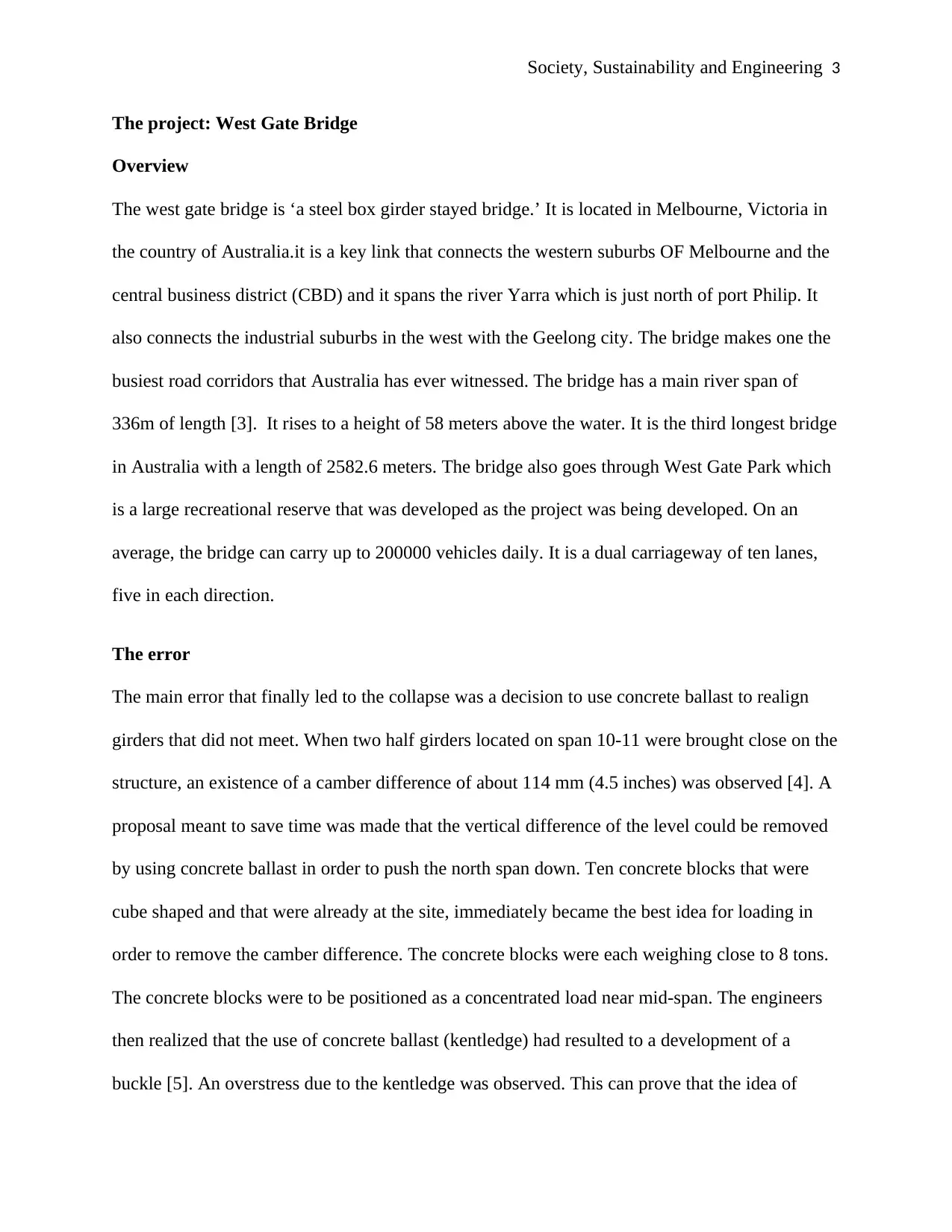
Society, Sustainability and Engineering 3
The project: West Gate Bridge
Overview
The west gate bridge is ‘a steel box girder stayed bridge.’ It is located in Melbourne, Victoria in
the country of Australia.it is a key link that connects the western suburbs OF Melbourne and the
central business district (CBD) and it spans the river Yarra which is just north of port Philip. It
also connects the industrial suburbs in the west with the Geelong city. The bridge makes one the
busiest road corridors that Australia has ever witnessed. The bridge has a main river span of
336m of length [3]. It rises to a height of 58 meters above the water. It is the third longest bridge
in Australia with a length of 2582.6 meters. The bridge also goes through West Gate Park which
is a large recreational reserve that was developed as the project was being developed. On an
average, the bridge can carry up to 200000 vehicles daily. It is a dual carriageway of ten lanes,
five in each direction.
The error
The main error that finally led to the collapse was a decision to use concrete ballast to realign
girders that did not meet. When two half girders located on span 10-11 were brought close on the
structure, an existence of a camber difference of about 114 mm (4.5 inches) was observed [4]. A
proposal meant to save time was made that the vertical difference of the level could be removed
by using concrete ballast in order to push the north span down. Ten concrete blocks that were
cube shaped and that were already at the site, immediately became the best idea for loading in
order to remove the camber difference. The concrete blocks were each weighing close to 8 tons.
The concrete blocks were to be positioned as a concentrated load near mid-span. The engineers
then realized that the use of concrete ballast (kentledge) had resulted to a development of a
buckle [5]. An overstress due to the kentledge was observed. This can prove that the idea of
The project: West Gate Bridge
Overview
The west gate bridge is ‘a steel box girder stayed bridge.’ It is located in Melbourne, Victoria in
the country of Australia.it is a key link that connects the western suburbs OF Melbourne and the
central business district (CBD) and it spans the river Yarra which is just north of port Philip. It
also connects the industrial suburbs in the west with the Geelong city. The bridge makes one the
busiest road corridors that Australia has ever witnessed. The bridge has a main river span of
336m of length [3]. It rises to a height of 58 meters above the water. It is the third longest bridge
in Australia with a length of 2582.6 meters. The bridge also goes through West Gate Park which
is a large recreational reserve that was developed as the project was being developed. On an
average, the bridge can carry up to 200000 vehicles daily. It is a dual carriageway of ten lanes,
five in each direction.
The error
The main error that finally led to the collapse was a decision to use concrete ballast to realign
girders that did not meet. When two half girders located on span 10-11 were brought close on the
structure, an existence of a camber difference of about 114 mm (4.5 inches) was observed [4]. A
proposal meant to save time was made that the vertical difference of the level could be removed
by using concrete ballast in order to push the north span down. Ten concrete blocks that were
cube shaped and that were already at the site, immediately became the best idea for loading in
order to remove the camber difference. The concrete blocks were each weighing close to 8 tons.
The concrete blocks were to be positioned as a concentrated load near mid-span. The engineers
then realized that the use of concrete ballast (kentledge) had resulted to a development of a
buckle [5]. An overstress due to the kentledge was observed. This can prove that the idea of
⊘ This is a preview!⊘
Do you want full access?
Subscribe today to unlock all pages.

Trusted by 1+ million students worldwide
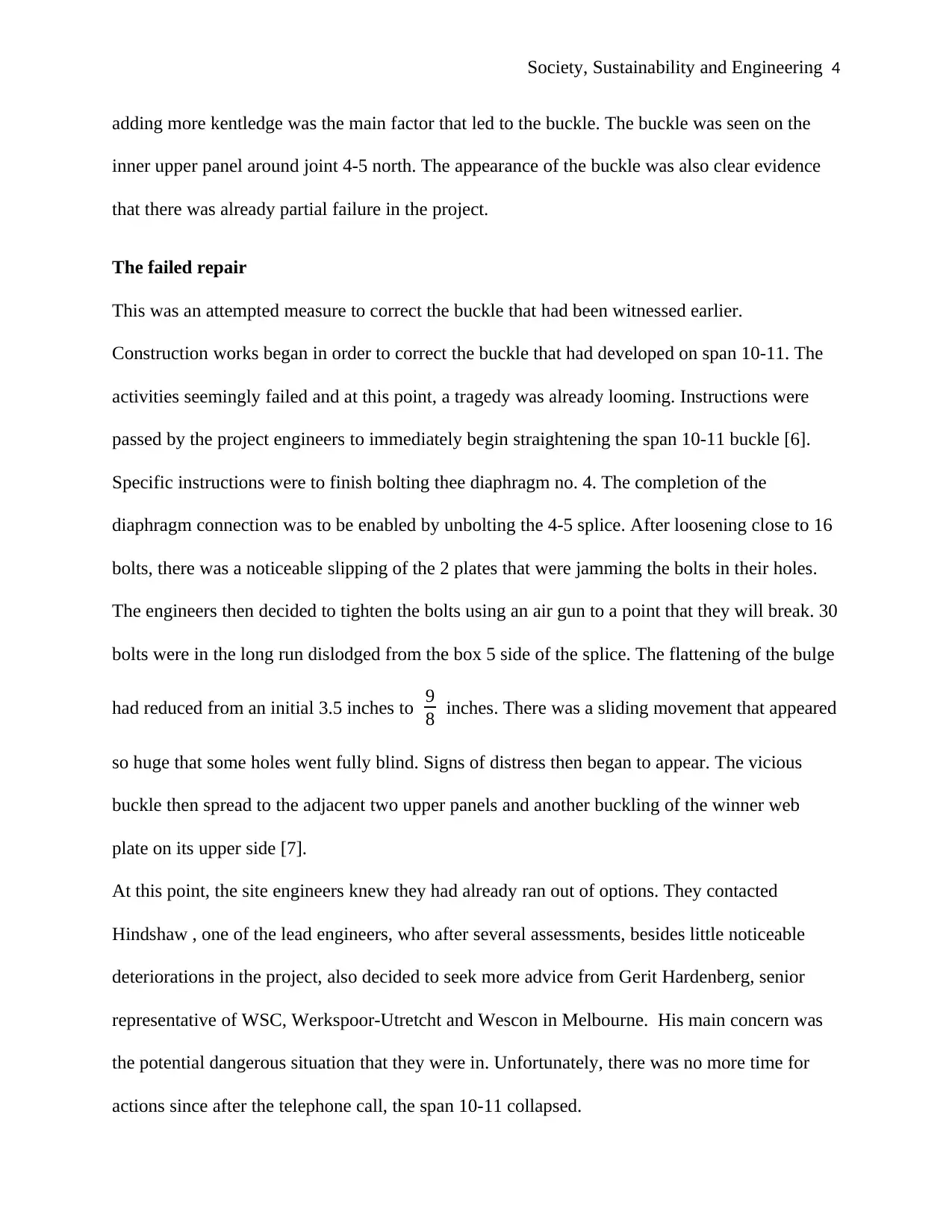
Society, Sustainability and Engineering 4
adding more kentledge was the main factor that led to the buckle. The buckle was seen on the
inner upper panel around joint 4-5 north. The appearance of the buckle was also clear evidence
that there was already partial failure in the project.
The failed repair
This was an attempted measure to correct the buckle that had been witnessed earlier.
Construction works began in order to correct the buckle that had developed on span 10-11. The
activities seemingly failed and at this point, a tragedy was already looming. Instructions were
passed by the project engineers to immediately begin straightening the span 10-11 buckle [6].
Specific instructions were to finish bolting thee diaphragm no. 4. The completion of the
diaphragm connection was to be enabled by unbolting the 4-5 splice. After loosening close to 16
bolts, there was a noticeable slipping of the 2 plates that were jamming the bolts in their holes.
The engineers then decided to tighten the bolts using an air gun to a point that they will break. 30
bolts were in the long run dislodged from the box 5 side of the splice. The flattening of the bulge
had reduced from an initial 3.5 inches to 9
8 inches. There was a sliding movement that appeared
so huge that some holes went fully blind. Signs of distress then began to appear. The vicious
buckle then spread to the adjacent two upper panels and another buckling of the winner web
plate on its upper side [7].
At this point, the site engineers knew they had already ran out of options. They contacted
Hindshaw , one of the lead engineers, who after several assessments, besides little noticeable
deteriorations in the project, also decided to seek more advice from Gerit Hardenberg, senior
representative of WSC, Werkspoor-Utretcht and Wescon in Melbourne. His main concern was
the potential dangerous situation that they were in. Unfortunately, there was no more time for
actions since after the telephone call, the span 10-11 collapsed.
adding more kentledge was the main factor that led to the buckle. The buckle was seen on the
inner upper panel around joint 4-5 north. The appearance of the buckle was also clear evidence
that there was already partial failure in the project.
The failed repair
This was an attempted measure to correct the buckle that had been witnessed earlier.
Construction works began in order to correct the buckle that had developed on span 10-11. The
activities seemingly failed and at this point, a tragedy was already looming. Instructions were
passed by the project engineers to immediately begin straightening the span 10-11 buckle [6].
Specific instructions were to finish bolting thee diaphragm no. 4. The completion of the
diaphragm connection was to be enabled by unbolting the 4-5 splice. After loosening close to 16
bolts, there was a noticeable slipping of the 2 plates that were jamming the bolts in their holes.
The engineers then decided to tighten the bolts using an air gun to a point that they will break. 30
bolts were in the long run dislodged from the box 5 side of the splice. The flattening of the bulge
had reduced from an initial 3.5 inches to 9
8 inches. There was a sliding movement that appeared
so huge that some holes went fully blind. Signs of distress then began to appear. The vicious
buckle then spread to the adjacent two upper panels and another buckling of the winner web
plate on its upper side [7].
At this point, the site engineers knew they had already ran out of options. They contacted
Hindshaw , one of the lead engineers, who after several assessments, besides little noticeable
deteriorations in the project, also decided to seek more advice from Gerit Hardenberg, senior
representative of WSC, Werkspoor-Utretcht and Wescon in Melbourne. His main concern was
the potential dangerous situation that they were in. Unfortunately, there was no more time for
actions since after the telephone call, the span 10-11 collapsed.
Paraphrase This Document
Need a fresh take? Get an instant paraphrase of this document with our AI Paraphraser
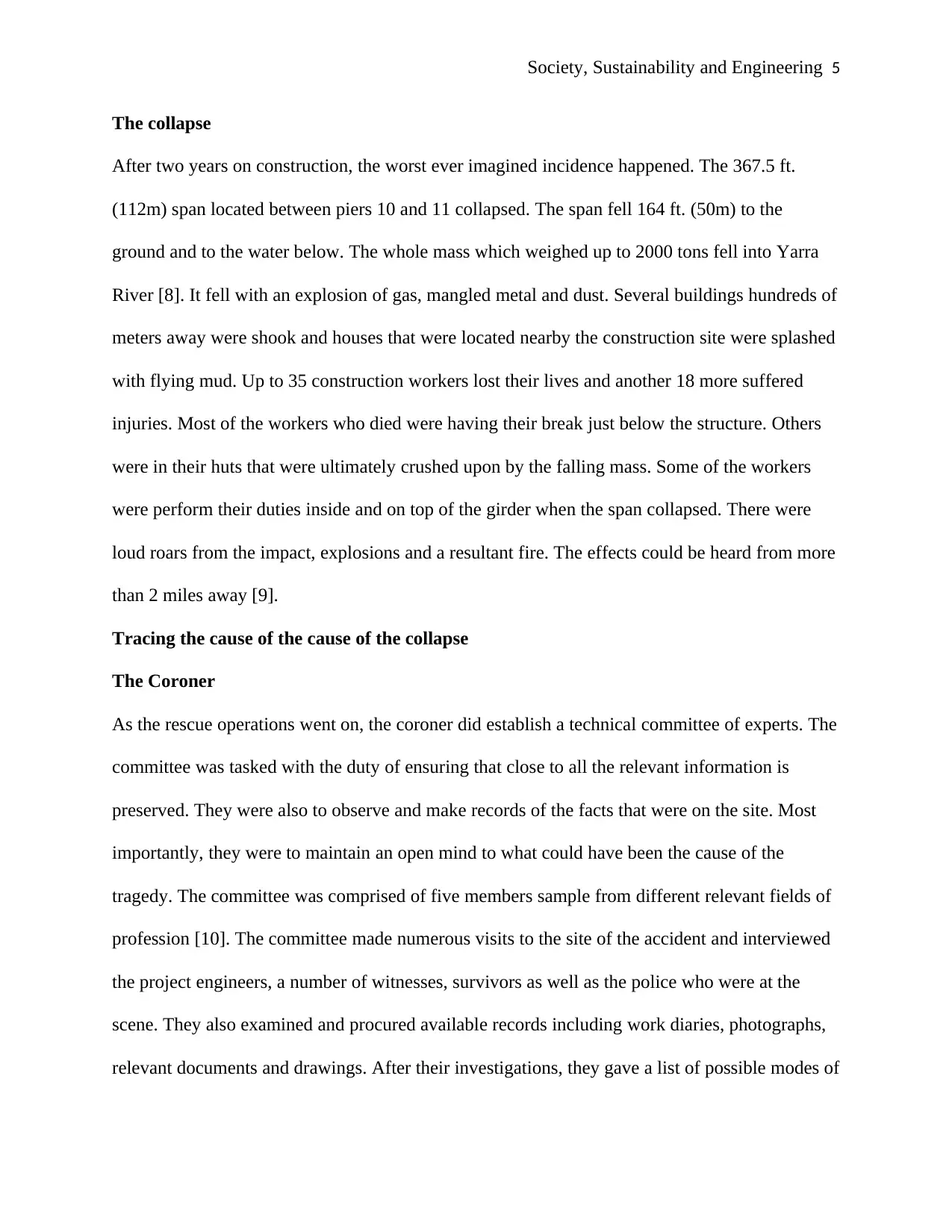
Society, Sustainability and Engineering 5
The collapse
After two years on construction, the worst ever imagined incidence happened. The 367.5 ft.
(112m) span located between piers 10 and 11 collapsed. The span fell 164 ft. (50m) to the
ground and to the water below. The whole mass which weighed up to 2000 tons fell into Yarra
River [8]. It fell with an explosion of gas, mangled metal and dust. Several buildings hundreds of
meters away were shook and houses that were located nearby the construction site were splashed
with flying mud. Up to 35 construction workers lost their lives and another 18 more suffered
injuries. Most of the workers who died were having their break just below the structure. Others
were in their huts that were ultimately crushed upon by the falling mass. Some of the workers
were perform their duties inside and on top of the girder when the span collapsed. There were
loud roars from the impact, explosions and a resultant fire. The effects could be heard from more
than 2 miles away [9].
Tracing the cause of the cause of the collapse
The Coroner
As the rescue operations went on, the coroner did establish a technical committee of experts. The
committee was tasked with the duty of ensuring that close to all the relevant information is
preserved. They were also to observe and make records of the facts that were on the site. Most
importantly, they were to maintain an open mind to what could have been the cause of the
tragedy. The committee was comprised of five members sample from different relevant fields of
profession [10]. The committee made numerous visits to the site of the accident and interviewed
the project engineers, a number of witnesses, survivors as well as the police who were at the
scene. They also examined and procured available records including work diaries, photographs,
relevant documents and drawings. After their investigations, they gave a list of possible modes of
The collapse
After two years on construction, the worst ever imagined incidence happened. The 367.5 ft.
(112m) span located between piers 10 and 11 collapsed. The span fell 164 ft. (50m) to the
ground and to the water below. The whole mass which weighed up to 2000 tons fell into Yarra
River [8]. It fell with an explosion of gas, mangled metal and dust. Several buildings hundreds of
meters away were shook and houses that were located nearby the construction site were splashed
with flying mud. Up to 35 construction workers lost their lives and another 18 more suffered
injuries. Most of the workers who died were having their break just below the structure. Others
were in their huts that were ultimately crushed upon by the falling mass. Some of the workers
were perform their duties inside and on top of the girder when the span collapsed. There were
loud roars from the impact, explosions and a resultant fire. The effects could be heard from more
than 2 miles away [9].
Tracing the cause of the cause of the collapse
The Coroner
As the rescue operations went on, the coroner did establish a technical committee of experts. The
committee was tasked with the duty of ensuring that close to all the relevant information is
preserved. They were also to observe and make records of the facts that were on the site. Most
importantly, they were to maintain an open mind to what could have been the cause of the
tragedy. The committee was comprised of five members sample from different relevant fields of
profession [10]. The committee made numerous visits to the site of the accident and interviewed
the project engineers, a number of witnesses, survivors as well as the police who were at the
scene. They also examined and procured available records including work diaries, photographs,
relevant documents and drawings. After their investigations, they gave a list of possible modes of
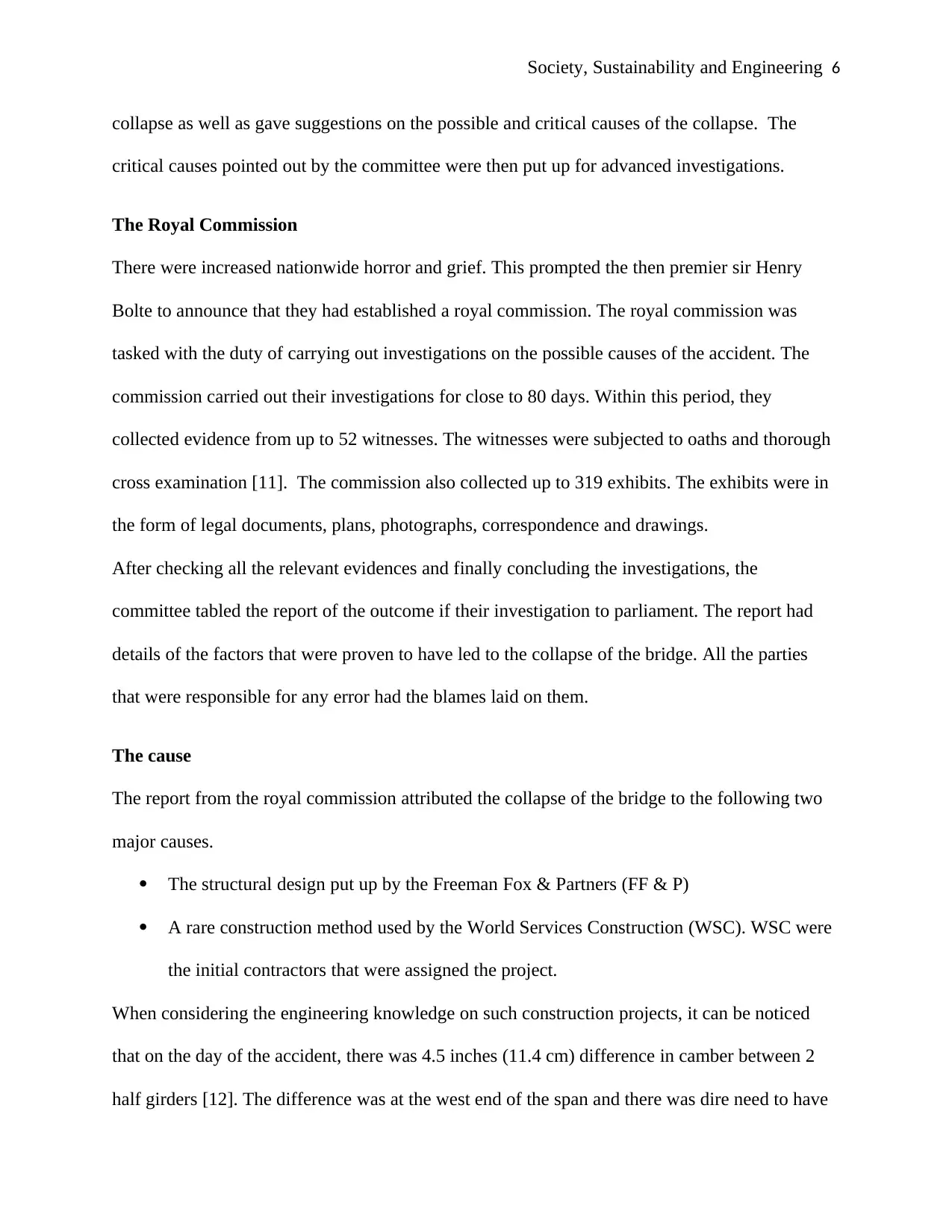
Society, Sustainability and Engineering 6
collapse as well as gave suggestions on the possible and critical causes of the collapse. The
critical causes pointed out by the committee were then put up for advanced investigations.
The Royal Commission
There were increased nationwide horror and grief. This prompted the then premier sir Henry
Bolte to announce that they had established a royal commission. The royal commission was
tasked with the duty of carrying out investigations on the possible causes of the accident. The
commission carried out their investigations for close to 80 days. Within this period, they
collected evidence from up to 52 witnesses. The witnesses were subjected to oaths and thorough
cross examination [11]. The commission also collected up to 319 exhibits. The exhibits were in
the form of legal documents, plans, photographs, correspondence and drawings.
After checking all the relevant evidences and finally concluding the investigations, the
committee tabled the report of the outcome if their investigation to parliament. The report had
details of the factors that were proven to have led to the collapse of the bridge. All the parties
that were responsible for any error had the blames laid on them.
The cause
The report from the royal commission attributed the collapse of the bridge to the following two
major causes.
The structural design put up by the Freeman Fox & Partners (FF & P)
A rare construction method used by the World Services Construction (WSC). WSC were
the initial contractors that were assigned the project.
When considering the engineering knowledge on such construction projects, it can be noticed
that on the day of the accident, there was 4.5 inches (11.4 cm) difference in camber between 2
half girders [12]. The difference was at the west end of the span and there was dire need to have
collapse as well as gave suggestions on the possible and critical causes of the collapse. The
critical causes pointed out by the committee were then put up for advanced investigations.
The Royal Commission
There were increased nationwide horror and grief. This prompted the then premier sir Henry
Bolte to announce that they had established a royal commission. The royal commission was
tasked with the duty of carrying out investigations on the possible causes of the accident. The
commission carried out their investigations for close to 80 days. Within this period, they
collected evidence from up to 52 witnesses. The witnesses were subjected to oaths and thorough
cross examination [11]. The commission also collected up to 319 exhibits. The exhibits were in
the form of legal documents, plans, photographs, correspondence and drawings.
After checking all the relevant evidences and finally concluding the investigations, the
committee tabled the report of the outcome if their investigation to parliament. The report had
details of the factors that were proven to have led to the collapse of the bridge. All the parties
that were responsible for any error had the blames laid on them.
The cause
The report from the royal commission attributed the collapse of the bridge to the following two
major causes.
The structural design put up by the Freeman Fox & Partners (FF & P)
A rare construction method used by the World Services Construction (WSC). WSC were
the initial contractors that were assigned the project.
When considering the engineering knowledge on such construction projects, it can be noticed
that on the day of the accident, there was 4.5 inches (11.4 cm) difference in camber between 2
half girders [12]. The difference was at the west end of the span and there was dire need to have
⊘ This is a preview!⊘
Do you want full access?
Subscribe today to unlock all pages.

Trusted by 1+ million students worldwide
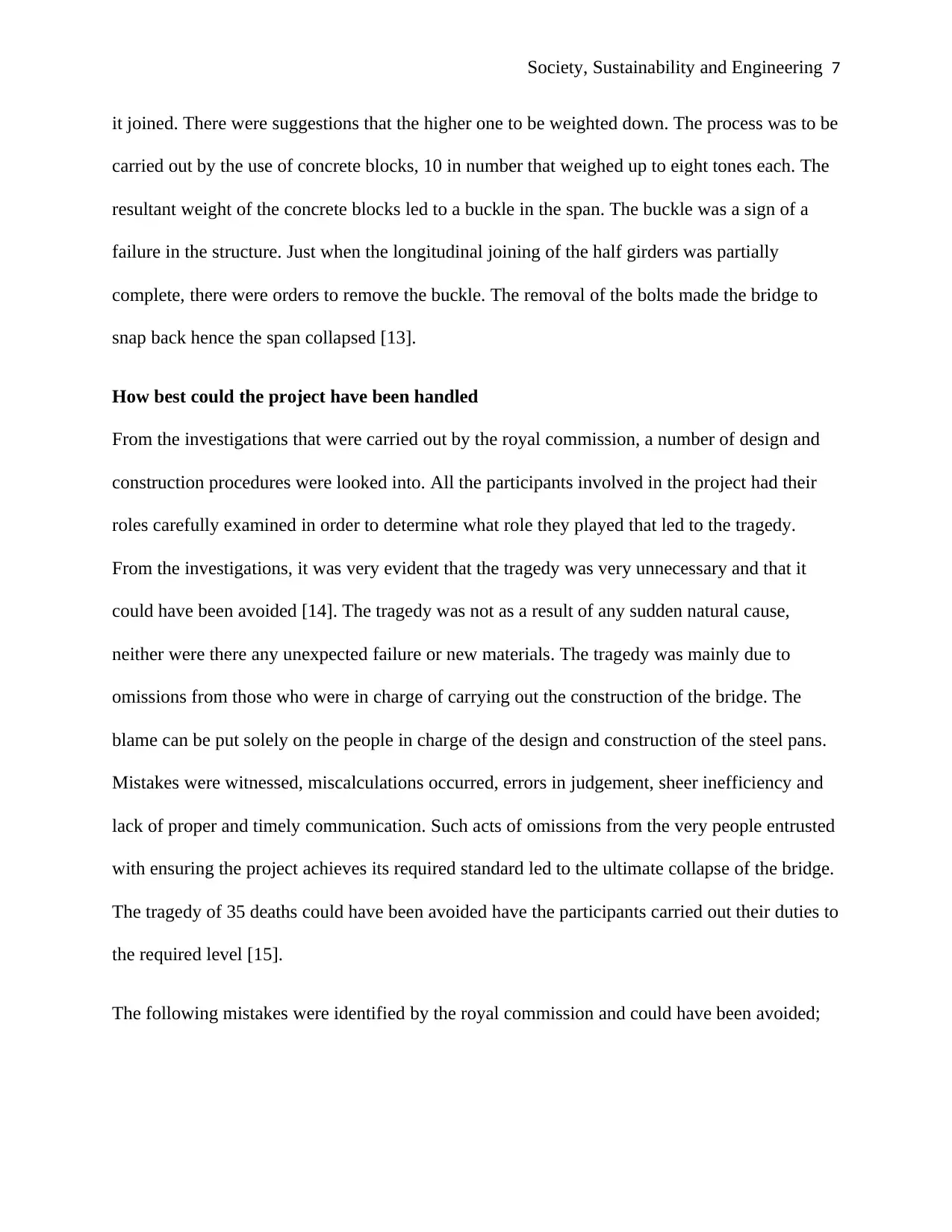
Society, Sustainability and Engineering 7
it joined. There were suggestions that the higher one to be weighted down. The process was to be
carried out by the use of concrete blocks, 10 in number that weighed up to eight tones each. The
resultant weight of the concrete blocks led to a buckle in the span. The buckle was a sign of a
failure in the structure. Just when the longitudinal joining of the half girders was partially
complete, there were orders to remove the buckle. The removal of the bolts made the bridge to
snap back hence the span collapsed [13].
How best could the project have been handled
From the investigations that were carried out by the royal commission, a number of design and
construction procedures were looked into. All the participants involved in the project had their
roles carefully examined in order to determine what role they played that led to the tragedy.
From the investigations, it was very evident that the tragedy was very unnecessary and that it
could have been avoided [14]. The tragedy was not as a result of any sudden natural cause,
neither were there any unexpected failure or new materials. The tragedy was mainly due to
omissions from those who were in charge of carrying out the construction of the bridge. The
blame can be put solely on the people in charge of the design and construction of the steel pans.
Mistakes were witnessed, miscalculations occurred, errors in judgement, sheer inefficiency and
lack of proper and timely communication. Such acts of omissions from the very people entrusted
with ensuring the project achieves its required standard led to the ultimate collapse of the bridge.
The tragedy of 35 deaths could have been avoided have the participants carried out their duties to
the required level [15].
The following mistakes were identified by the royal commission and could have been avoided;
it joined. There were suggestions that the higher one to be weighted down. The process was to be
carried out by the use of concrete blocks, 10 in number that weighed up to eight tones each. The
resultant weight of the concrete blocks led to a buckle in the span. The buckle was a sign of a
failure in the structure. Just when the longitudinal joining of the half girders was partially
complete, there were orders to remove the buckle. The removal of the bolts made the bridge to
snap back hence the span collapsed [13].
How best could the project have been handled
From the investigations that were carried out by the royal commission, a number of design and
construction procedures were looked into. All the participants involved in the project had their
roles carefully examined in order to determine what role they played that led to the tragedy.
From the investigations, it was very evident that the tragedy was very unnecessary and that it
could have been avoided [14]. The tragedy was not as a result of any sudden natural cause,
neither were there any unexpected failure or new materials. The tragedy was mainly due to
omissions from those who were in charge of carrying out the construction of the bridge. The
blame can be put solely on the people in charge of the design and construction of the steel pans.
Mistakes were witnessed, miscalculations occurred, errors in judgement, sheer inefficiency and
lack of proper and timely communication. Such acts of omissions from the very people entrusted
with ensuring the project achieves its required standard led to the ultimate collapse of the bridge.
The tragedy of 35 deaths could have been avoided have the participants carried out their duties to
the required level [15].
The following mistakes were identified by the royal commission and could have been avoided;
Paraphrase This Document
Need a fresh take? Get an instant paraphrase of this document with our AI Paraphraser
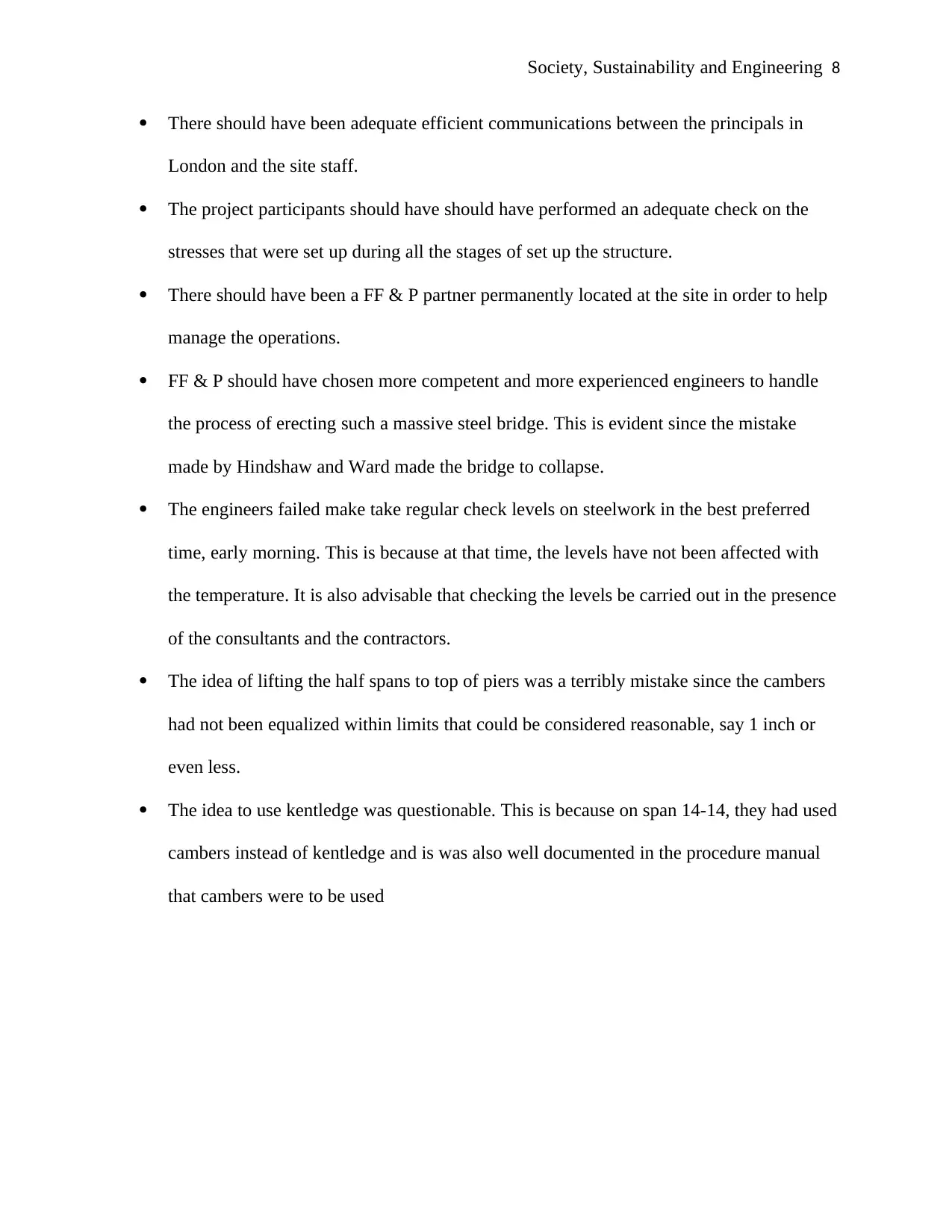
Society, Sustainability and Engineering 8
There should have been adequate efficient communications between the principals in
London and the site staff.
The project participants should have should have performed an adequate check on the
stresses that were set up during all the stages of set up the structure.
There should have been a FF & P partner permanently located at the site in order to help
manage the operations.
FF & P should have chosen more competent and more experienced engineers to handle
the process of erecting such a massive steel bridge. This is evident since the mistake
made by Hindshaw and Ward made the bridge to collapse.
The engineers failed make take regular check levels on steelwork in the best preferred
time, early morning. This is because at that time, the levels have not been affected with
the temperature. It is also advisable that checking the levels be carried out in the presence
of the consultants and the contractors.
The idea of lifting the half spans to top of piers was a terribly mistake since the cambers
had not been equalized within limits that could be considered reasonable, say 1 inch or
even less.
The idea to use kentledge was questionable. This is because on span 14-14, they had used
cambers instead of kentledge and is was also well documented in the procedure manual
that cambers were to be used
There should have been adequate efficient communications between the principals in
London and the site staff.
The project participants should have should have performed an adequate check on the
stresses that were set up during all the stages of set up the structure.
There should have been a FF & P partner permanently located at the site in order to help
manage the operations.
FF & P should have chosen more competent and more experienced engineers to handle
the process of erecting such a massive steel bridge. This is evident since the mistake
made by Hindshaw and Ward made the bridge to collapse.
The engineers failed make take regular check levels on steelwork in the best preferred
time, early morning. This is because at that time, the levels have not been affected with
the temperature. It is also advisable that checking the levels be carried out in the presence
of the consultants and the contractors.
The idea of lifting the half spans to top of piers was a terribly mistake since the cambers
had not been equalized within limits that could be considered reasonable, say 1 inch or
even less.
The idea to use kentledge was questionable. This is because on span 14-14, they had used
cambers instead of kentledge and is was also well documented in the procedure manual
that cambers were to be used
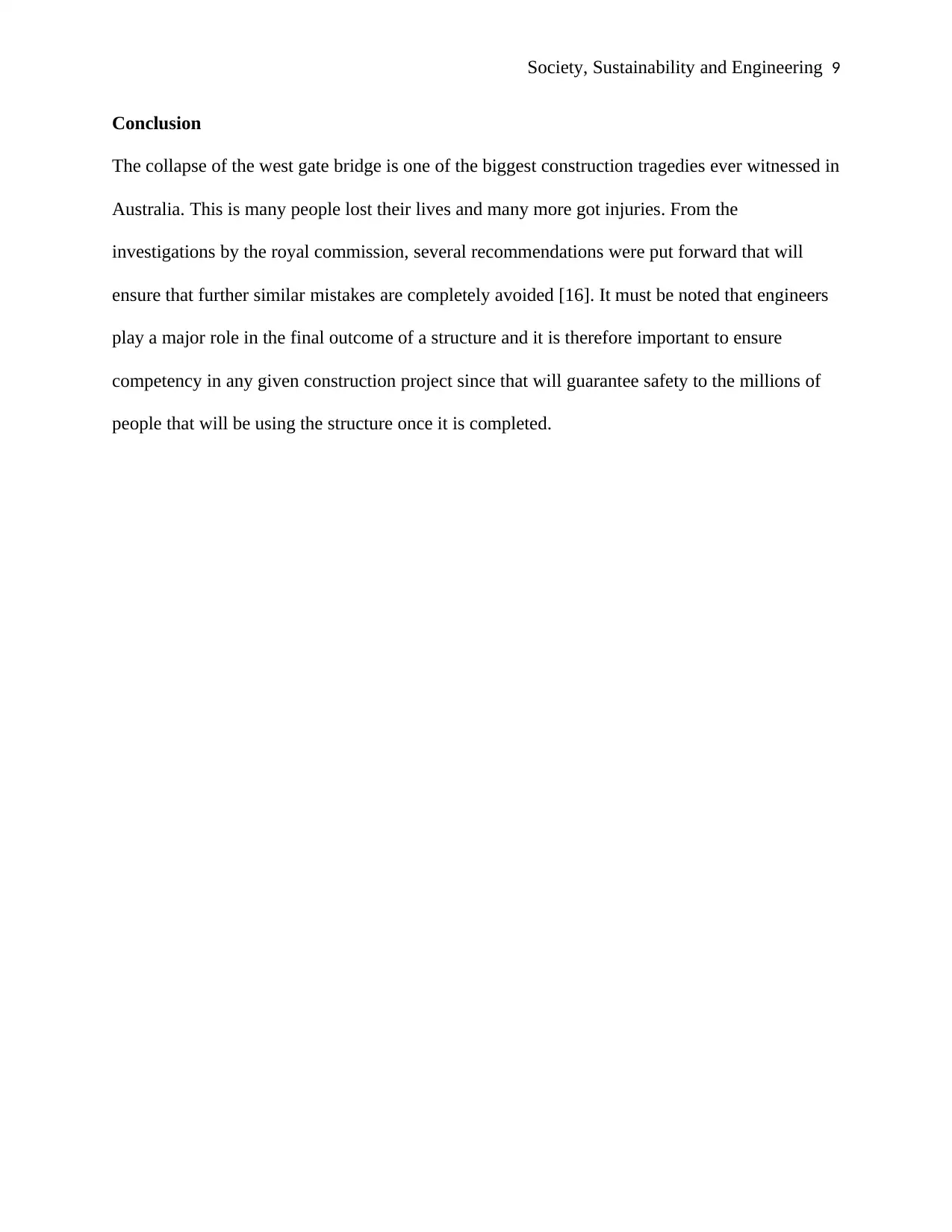
Society, Sustainability and Engineering 9
Conclusion
The collapse of the west gate bridge is one of the biggest construction tragedies ever witnessed in
Australia. This is many people lost their lives and many more got injuries. From the
investigations by the royal commission, several recommendations were put forward that will
ensure that further similar mistakes are completely avoided [16]. It must be noted that engineers
play a major role in the final outcome of a structure and it is therefore important to ensure
competency in any given construction project since that will guarantee safety to the millions of
people that will be using the structure once it is completed.
Conclusion
The collapse of the west gate bridge is one of the biggest construction tragedies ever witnessed in
Australia. This is many people lost their lives and many more got injuries. From the
investigations by the royal commission, several recommendations were put forward that will
ensure that further similar mistakes are completely avoided [16]. It must be noted that engineers
play a major role in the final outcome of a structure and it is therefore important to ensure
competency in any given construction project since that will guarantee safety to the millions of
people that will be using the structure once it is completed.
⊘ This is a preview!⊘
Do you want full access?
Subscribe today to unlock all pages.

Trusted by 1+ million students worldwide
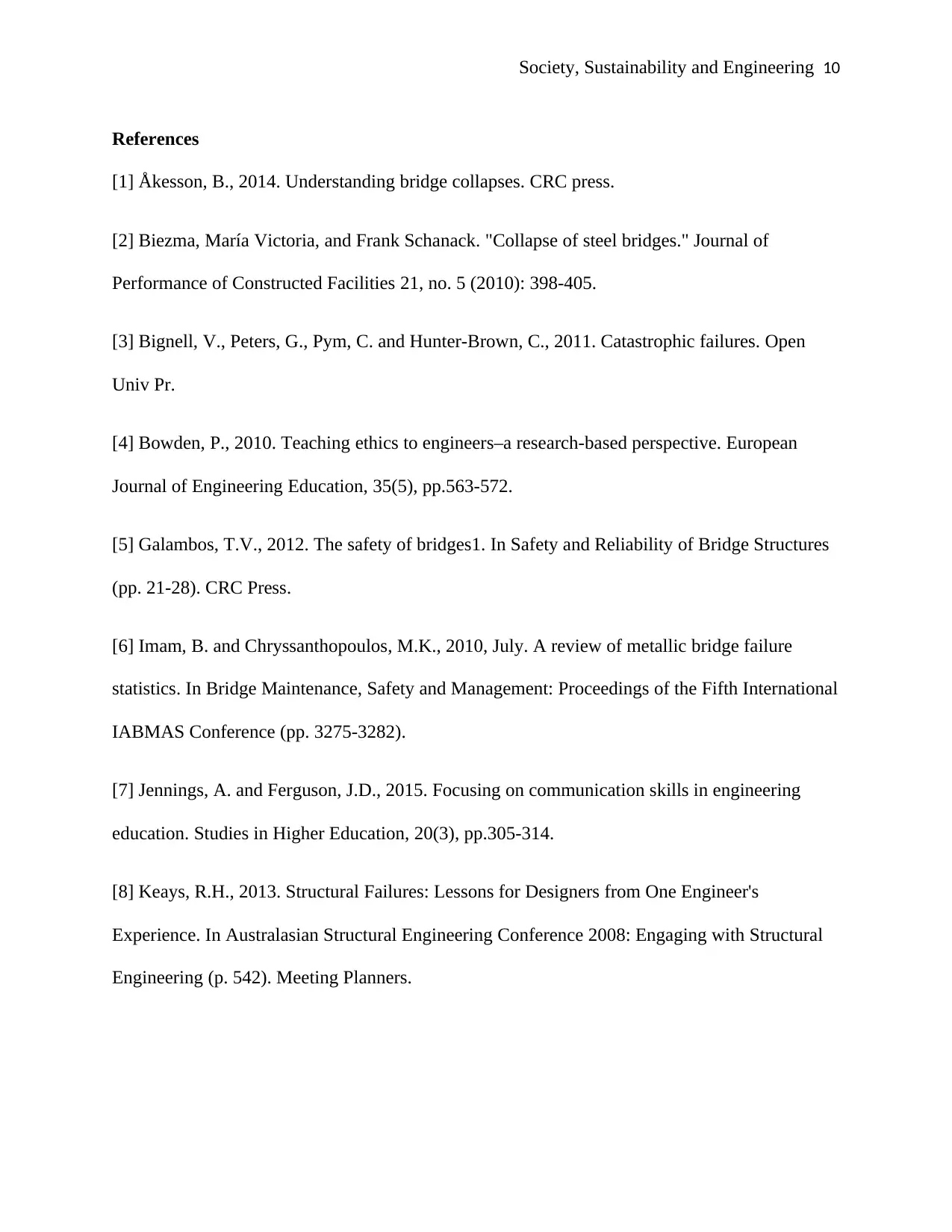
Society, Sustainability and Engineering 10
References
[1] Åkesson, B., 2014. Understanding bridge collapses. CRC press.
[2] Biezma, María Victoria, and Frank Schanack. "Collapse of steel bridges." Journal of
Performance of Constructed Facilities 21, no. 5 (2010): 398-405.
[3] Bignell, V., Peters, G., Pym, C. and Hunter-Brown, C., 2011. Catastrophic failures. Open
Univ Pr.
[4] Bowden, P., 2010. Teaching ethics to engineers–a research-based perspective. European
Journal of Engineering Education, 35(5), pp.563-572.
[5] Galambos, T.V., 2012. The safety of bridges1. In Safety and Reliability of Bridge Structures
(pp. 21-28). CRC Press.
[6] Imam, B. and Chryssanthopoulos, M.K., 2010, July. A review of metallic bridge failure
statistics. In Bridge Maintenance, Safety and Management: Proceedings of the Fifth International
IABMAS Conference (pp. 3275-3282).
[7] Jennings, A. and Ferguson, J.D., 2015. Focusing on communication skills in engineering
education. Studies in Higher Education, 20(3), pp.305-314.
[8] Keays, R.H., 2013. Structural Failures: Lessons for Designers from One Engineer's
Experience. In Australasian Structural Engineering Conference 2008: Engaging with Structural
Engineering (p. 542). Meeting Planners.
References
[1] Åkesson, B., 2014. Understanding bridge collapses. CRC press.
[2] Biezma, María Victoria, and Frank Schanack. "Collapse of steel bridges." Journal of
Performance of Constructed Facilities 21, no. 5 (2010): 398-405.
[3] Bignell, V., Peters, G., Pym, C. and Hunter-Brown, C., 2011. Catastrophic failures. Open
Univ Pr.
[4] Bowden, P., 2010. Teaching ethics to engineers–a research-based perspective. European
Journal of Engineering Education, 35(5), pp.563-572.
[5] Galambos, T.V., 2012. The safety of bridges1. In Safety and Reliability of Bridge Structures
(pp. 21-28). CRC Press.
[6] Imam, B. and Chryssanthopoulos, M.K., 2010, July. A review of metallic bridge failure
statistics. In Bridge Maintenance, Safety and Management: Proceedings of the Fifth International
IABMAS Conference (pp. 3275-3282).
[7] Jennings, A. and Ferguson, J.D., 2015. Focusing on communication skills in engineering
education. Studies in Higher Education, 20(3), pp.305-314.
[8] Keays, R.H., 2013. Structural Failures: Lessons for Designers from One Engineer's
Experience. In Australasian Structural Engineering Conference 2008: Engaging with Structural
Engineering (p. 542). Meeting Planners.
Paraphrase This Document
Need a fresh take? Get an instant paraphrase of this document with our AI Paraphraser
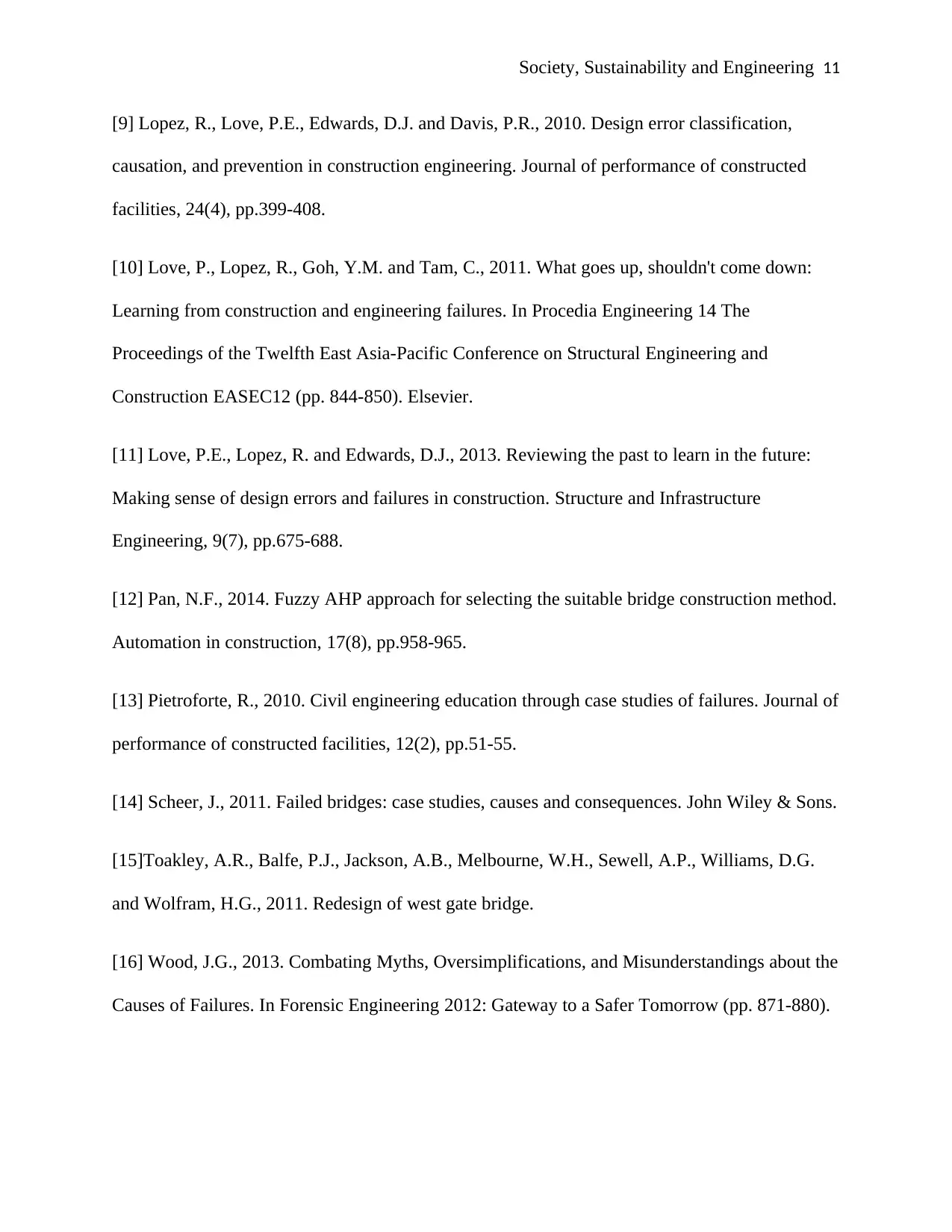
Society, Sustainability and Engineering 11
[9] Lopez, R., Love, P.E., Edwards, D.J. and Davis, P.R., 2010. Design error classification,
causation, and prevention in construction engineering. Journal of performance of constructed
facilities, 24(4), pp.399-408.
[10] Love, P., Lopez, R., Goh, Y.M. and Tam, C., 2011. What goes up, shouldn't come down:
Learning from construction and engineering failures. In Procedia Engineering 14 The
Proceedings of the Twelfth East Asia-Pacific Conference on Structural Engineering and
Construction EASEC12 (pp. 844-850). Elsevier.
[11] Love, P.E., Lopez, R. and Edwards, D.J., 2013. Reviewing the past to learn in the future:
Making sense of design errors and failures in construction. Structure and Infrastructure
Engineering, 9(7), pp.675-688.
[12] Pan, N.F., 2014. Fuzzy AHP approach for selecting the suitable bridge construction method.
Automation in construction, 17(8), pp.958-965.
[13] Pietroforte, R., 2010. Civil engineering education through case studies of failures. Journal of
performance of constructed facilities, 12(2), pp.51-55.
[14] Scheer, J., 2011. Failed bridges: case studies, causes and consequences. John Wiley & Sons.
[15]Toakley, A.R., Balfe, P.J., Jackson, A.B., Melbourne, W.H., Sewell, A.P., Williams, D.G.
and Wolfram, H.G., 2011. Redesign of west gate bridge.
[16] Wood, J.G., 2013. Combating Myths, Oversimplifications, and Misunderstandings about the
Causes of Failures. In Forensic Engineering 2012: Gateway to a Safer Tomorrow (pp. 871-880).
[9] Lopez, R., Love, P.E., Edwards, D.J. and Davis, P.R., 2010. Design error classification,
causation, and prevention in construction engineering. Journal of performance of constructed
facilities, 24(4), pp.399-408.
[10] Love, P., Lopez, R., Goh, Y.M. and Tam, C., 2011. What goes up, shouldn't come down:
Learning from construction and engineering failures. In Procedia Engineering 14 The
Proceedings of the Twelfth East Asia-Pacific Conference on Structural Engineering and
Construction EASEC12 (pp. 844-850). Elsevier.
[11] Love, P.E., Lopez, R. and Edwards, D.J., 2013. Reviewing the past to learn in the future:
Making sense of design errors and failures in construction. Structure and Infrastructure
Engineering, 9(7), pp.675-688.
[12] Pan, N.F., 2014. Fuzzy AHP approach for selecting the suitable bridge construction method.
Automation in construction, 17(8), pp.958-965.
[13] Pietroforte, R., 2010. Civil engineering education through case studies of failures. Journal of
performance of constructed facilities, 12(2), pp.51-55.
[14] Scheer, J., 2011. Failed bridges: case studies, causes and consequences. John Wiley & Sons.
[15]Toakley, A.R., Balfe, P.J., Jackson, A.B., Melbourne, W.H., Sewell, A.P., Williams, D.G.
and Wolfram, H.G., 2011. Redesign of west gate bridge.
[16] Wood, J.G., 2013. Combating Myths, Oversimplifications, and Misunderstandings about the
Causes of Failures. In Forensic Engineering 2012: Gateway to a Safer Tomorrow (pp. 871-880).
1 out of 11
Your All-in-One AI-Powered Toolkit for Academic Success.
+13062052269
info@desklib.com
Available 24*7 on WhatsApp / Email
![[object Object]](/_next/static/media/star-bottom.7253800d.svg)
Unlock your academic potential
Copyright © 2020–2025 A2Z Services. All Rights Reserved. Developed and managed by ZUCOL.
